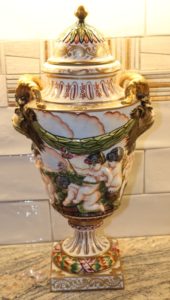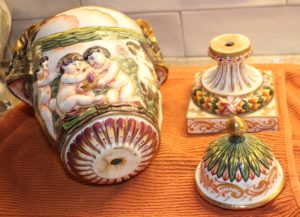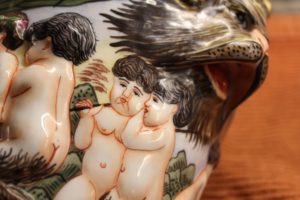 LH inherited two porcelain urns she displays in her home in Paso Robles. She asked me if they are ‘good’ Capodimonte. I answered, that they’re not the top of their style, but they make a great story.
LH inherited two porcelain urns she displays in her home in Paso Robles. She asked me if they are ‘good’ Capodimonte. I answered, that they’re not the top of their style, but they make a great story.
Giuseppe Gricci crafted the earliest examples of Capodimonte porcelains in the mid 1700’s for “The Royal Factory,” established by King Charles VII in Naples, Italy. In the 18th century, only a king possessed the money to establish a porcelain factory. In fact, porcelain only began to appear in Europe in the 18th century. Persia and China knew how to “make” porcelain, but Europe did NOT, until then. A Royal Personage opened a porcelain factory to create porcelain, a rich man’s folly, for his OWN palace.
The earliest Capodimonte figures were made for King Charles’s amusement or folly. Little human figures rendered in humorous and symbolic poses with beautifully painted faces and clothing. Many a Royal banquet table held a line of such figures traipsing down the center of the table around the bowls of fruit and flowers and sweetmeats.
These first figures are examples of early European hard paste porcelains
 Europeans finally found the secret of the elements that MADE porcelain. Porcelain was made from a specific combination of kaolin, quartz, and feldspar, fired at a specific high temperature, with the result a strong, non-porous medium. The elements I listed above vitrify when fired together, meaning that the three elements form a material stronger than each of them does separately. Add to this the glaze, which ALSO becomes “one” with the material, and you get a smooth, hard, glassy, translucent material. We are so used to porcelain, which we call china, after the place that discovered the elements, that we forget it once became discovered as a new technology.
Europeans finally found the secret of the elements that MADE porcelain. Porcelain was made from a specific combination of kaolin, quartz, and feldspar, fired at a specific high temperature, with the result a strong, non-porous medium. The elements I listed above vitrify when fired together, meaning that the three elements form a material stronger than each of them does separately. Add to this the glaze, which ALSO becomes “one” with the material, and you get a smooth, hard, glassy, translucent material. We are so used to porcelain, which we call china, after the place that discovered the elements, that we forget it once became discovered as a new technology.
King Charles’s son Ferdinand continued his Royal Father’s interest in porcelain through the early 1800’s, developing the distinct hallmark, a capital “N” (for Naples) crowned with a king’s crown. When Ferdinand’s interest waned other factories became established. In 1925 the Industria Lombardo Porcellane obtained the supposed exclusive rights to produce the style known as Capodimonte. But because so many factories all over Italy and Spain made wares resembling the style, we can’t determine with certainty that the “N” crowned hallmark on a piece designates original Capodimonte. The name, and the brand, also became the style.
My favorite piece of Capodimonte?
I witnessed a huge piece standing proud on a massive grand piano. A Cinderella Coach, a carriage pulled by four horses, decorated with flowers, at about 4 ft. long. The piece, rendered in blues and pinks, appeared so awful that I thought it actually fabulous. My clients explained that they received it as a gift from Liberace, who collected and gifted Capodimonte.
Liberace’s collection included florid renditions of realistic looking floral compositions, and not just figures, which are the famous and somewhat sickening Capodimonte flowers. The tradition goes back to Ferdinand’s Royal Father, the King of Naples. Allergic to real flowers, he ordered flowers copied in porcelain. Charles VII’s Royal Palace, the Portici, included a room completely decorated, floor to ceiling and beyond, with porcelain Capodimonte flowers. The whole room was moved, and is now displayed at the Capodimonte Museum in Naples.
LH’s urns are examples of recognizable “tourist” Capodimonte STYLE porcelain, marked with an “N” crowned hallmark, produced after 1925. The best Capodimonte is the OLD stuff, made for KINGS.
How do I know they are 20th and not 19th or 18th century?
 It’s in the detail. The faces on these urns aren’t rendered, but suggested loosely, and outlined in black to make them seem raised in relief. Develop an eye for quality, LH, even if you don’t like the material. Look at the precision of the artistry, the clarity of the painting, the balance of the design, and you’ll find the urns are less than expertly rendered.
It’s in the detail. The faces on these urns aren’t rendered, but suggested loosely, and outlined in black to make them seem raised in relief. Develop an eye for quality, LH, even if you don’t like the material. Look at the precision of the artistry, the clarity of the painting, the balance of the design, and you’ll find the urns are less than expertly rendered.
The cost of your pair? $400 on a good day. At this time in our collective “taste” level, this style and combinations of colors, and massing of naked angels, isn’t what the market wants. We call this Neoclassical Revival, not considered favorable. Maybe one day, when we return to Liberace’s taste.
Pingback: One's Porcelain, One's Not - Elizabeth Appraisals
Pingback: 1970s Table Lamp: A Swirling Compilation of Many Styles - Elizabeth Appraisals